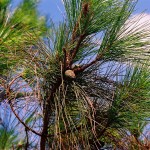- Species: Pinus massoniana
English Name: Chinese Red Pine
Chinese Name: 馬尾松
Family: Pinaceae
Description:
Pinaceae. Evergreen large tree. Leaves needle-shaped, dark green, in fascicles of 2, 12-20cm long. Flowers unisexual, monoecious, blooming in spring. Cones ovoid, ripe in winter.
Grows on sunny hills.
Preparation: Needle leaf, rosin, nodes, pollen, bark, branch tip, and kernel are used. Pollen is collected in spring, sun-dried and sifted.
Properties: Needle leaf: bitter, astringent in taste, warm in nature. Rosin: bitter, sweet in taste, warm in nature. Node: bitter in taste, warm in nature. Pollen: sweet in taste, warm in nature. Bark and branch tip: bitter, astringent in taste, warm in nature. Kernel: sweet in taste, warm in nature.
Actions and indications: Needle leaf: improves vision, calms mental state, removes toxic substance, relieves pruritus. Indicated for influenza, nyctalopia, hypertension, neurasthenia. Rosin: dries dampness, expels wind, promotes regeneration of tissue, alleviates pain. External use for infective and ulcerous disease of skin, eczema, traumatic bleeding, burn and scald. With mild toxicity. Node: expels wind and damp, activates collateral, alleviates pain. Indicated for rheumatic arthralgia, lumbago and scelalgia, traumatic swelling and pain. Pollen: relieves hemorrhage. Indicated for gastric and duodenal ulcer, hemoptysis. Bark: promotes regeneration of tissue. External use for burn or scald, children eczema. Ground into powder and mix with sesame oil for external spread or decocted with water for external wash. Branch tip: removes toxic substance, relieves intoxication of Manihot esculenta and Gelsemium elegans. Kernel: moistens lung, lumbricates intestine. Indicated for cough due to lung dryness; chronic constipation,

Photos used under a Creative Commons license
References:
– Department of Gardens and Green Areas, Civic and Municipal Affairs Bureau of Macao Special Administrative Region, South China Botanical Garden, Chinese Academy of Science 2005. Flora of Macao (Volume 1). Macao, SAR: Author

